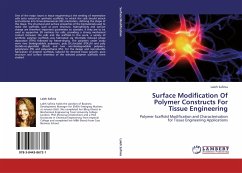Polymeric scaffolds provide a surface that can facilitate cell growth and tissue morphogenesis. Of particular interest is the role of nanoscale materials on cell behavior. Nanoscale topographies can be generated on two-dimensional polymeric substrates via reactive ion etching. The magnitude and morphology of the topography can be tailored by the gas media, etching time and power used. Cellular morphology, adhesion and differntiation can be controlled by altering the magnitude surface topography. The results suggest that cells can detect nanoscalar 2D surface topographies and alter their function in response to these environmental stimuli. Although nanofibrillar surfaces can be considered pseudo-three dimensional, they cannot produce 3D tissues. Thus to mimic the native ECM, nanofibrous 3D scaffolds are formed using electrospinning technology. Scaffolds can be manufactured in sheets or tubes and were shown to organize smooth muscles cells in a manner which imitates the natural tissue. Thus nanoscale biomaterials represent one method to control cell behavior and function.
Bitte wählen Sie Ihr Anliegen aus.
Rechnungen
Retourenschein anfordern
Bestellstatus
Storno








